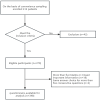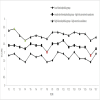Classification of kinesiophobia in patients after cardiac surgery under extracorporeal circulation in China: latent profile and influencing factors analysis from a cross-sectional study
- PMID: 39855652
- PMCID: PMC11758704
- DOI: 10.1136/bmjopen-2024-083909
Classification of kinesiophobia in patients after cardiac surgery under extracorporeal circulation in China: latent profile and influencing factors analysis from a cross-sectional study
Abstract
Objective: To investigate the potential classification of kinesiophobia in patients after cardiac surgery under extracorporeal circulation from a psychosocial perspective, and analyse the characteristic differences among different latent levels of patients.
Study design: This is a cross-sectional study of Chinese adults after cardiac surgery under extracorporeal circulation, aged 18 years and older, recruited from a tertiary hospital in North China.
Methods: This study uses latent profile analysis to identify potential classifications of kinesiophobia in questionnaires from 348 patients undergoing cardiac surgery under extracorporeal circulation. Multiple logistic regression analysis was used to evaluate the influencing factors at different latent classifications.
Results: The average performance of each indicator in Model 3 is best suited for analysis, Entropy=0.873 and bootstrap likelihood ratio test (p)<0.0001. The result of regression equation shows postoperative time (p<0.001), age, self-efficacy, pain and social support level (p<0.05) were the factors influencing the potential profile classification of patients after cardiac surgery under extracorporeal circulation.
Conclusion: The study identified three distinct classifications of patients: the low kinesiophobia group, the moderate kinesiophobia-high-risk perceived symptoms group and the high kinesiophobia-high exercise avoidance group (HK-HEAG). Addressing kinesiophobia, especially in older male patients during the early postoperative period, is crucial. Enhancing self-efficacy seems effective in reducing kinesiophobia, while increasing social support may not be as beneficial for the HK-HEAG. These findings provide a basis for implementing preventive interventions in cardiac rehabilitation.
Trial registration number: The research is registered with the Chinese Clinical Trial Registry (ChiCTR2200057895).
Keywords: Coronary heart disease; Cross-Sectional Studies; MENTAL HEALTH; Nursing Care.
© Author(s) (or their employer(s)) 2025. Re-use permitted under CC BY-NC. No commercial re-use. See rights and permissions. Published by BMJ Group.
Conflict of interest statement
Competing interests: None declared.
Figures
Similar articles
-
Kinesiophobia in patients after cardiac surgery: a scoping review.BMC Cardiovasc Disord. 2024 Sep 3;24(1):469. doi: 10.1186/s12872-024-04140-2. BMC Cardiovasc Disord. 2024. PMID: 39223455 Free PMC article.
-
Influencing factors of kinesiophobia in knee arthroplasty patients under the social cognitive theory: A structural equation model.Geriatr Nurs. 2024 Nov-Dec;60:270-280. doi: 10.1016/j.gerinurse.2024.09.004. Epub 2024 Sep 28. Geriatr Nurs. 2024. PMID: 39342894
-
Latent profile analysis of dyspnea-related kinesiophobia in older adults with chronic obstructive pulmonary disease.Heart Lung. 2025 Jan-Feb;69:241-247. doi: 10.1016/j.hrtlng.2024.10.016. Epub 2024 Nov 9. Heart Lung. 2025. PMID: 39522284
-
Influencing mechanisms of kinesiophobia in middle-aged and elderly patients with chronic obstructive pulmonary disease: a cross-sectional study.BMC Pulm Med. 2025 May 13;25(1):233. doi: 10.1186/s12890-025-03699-6. BMC Pulm Med. 2025. PMID: 40361050 Free PMC article.
-
Summary of the best evidence for the management of kinesiophobia in patients after cardiac surgery.BMC Cardiovasc Disord. 2025 Feb 24;25(1):127. doi: 10.1186/s12872-025-04570-6. BMC Cardiovasc Disord. 2025. PMID: 39994522 Free PMC article.
References
MeSH terms
LinkOut - more resources
Full Text Sources
Medical


